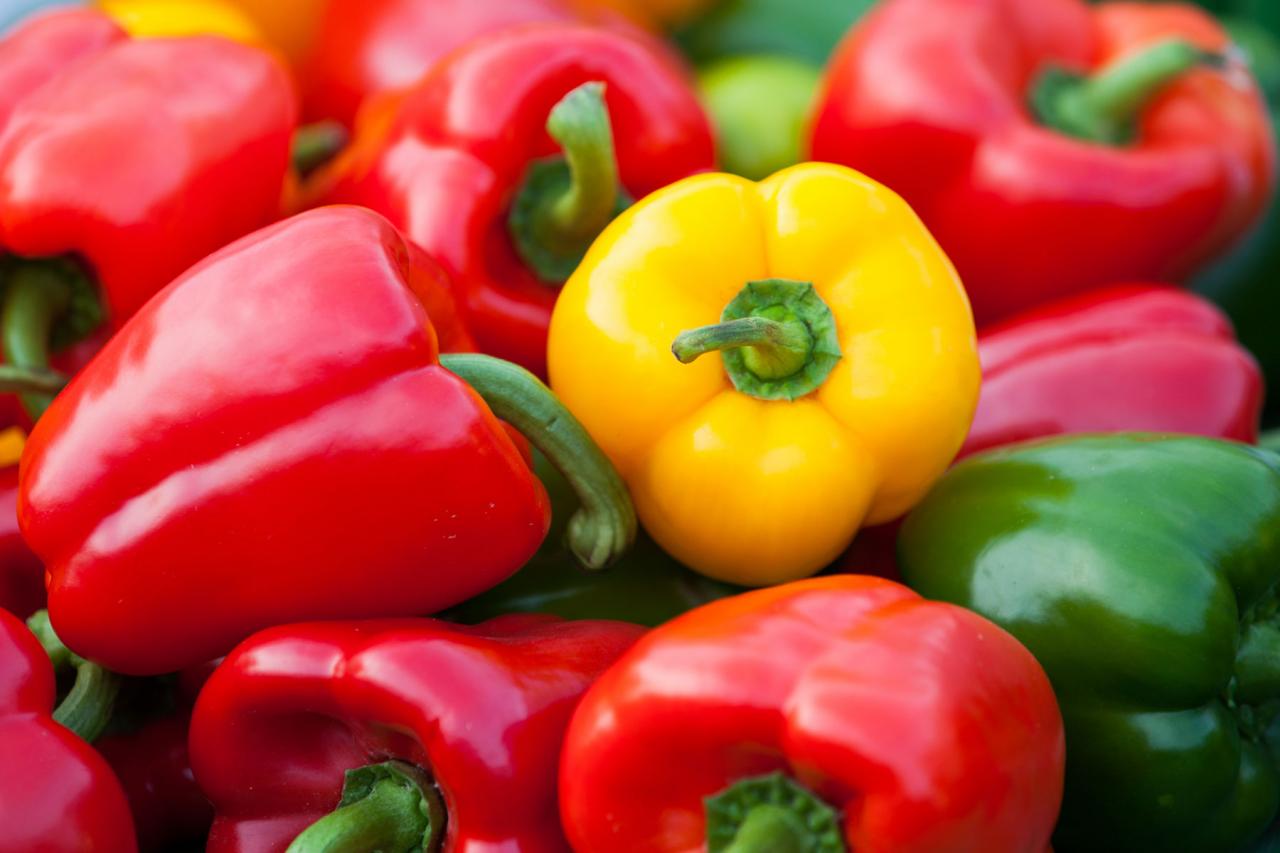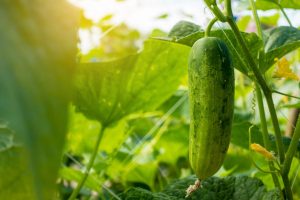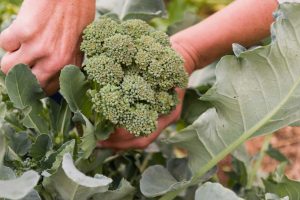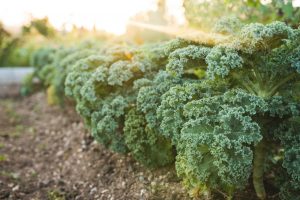

From sweet, crisp peppers in rainbow shades to habañeros hot enough to bring tears to your eyes, all peppers share a preference for a long, warm growing season. Set out plants a week or two after your last frost, when the weather is settled and warm. While cool weather reigns, keep seedlings indoors at night, and move them to a protected sunny spot outdoors during the day.
From sweet, crisp peppers in rainbow shades to habañeros hot enough to bring tears to your eyes, all peppers share a preference for a long, warm growing season. Set out plants a week or two after your last frost, when the weather is settled and warm. While cool weather reigns, keep seedlings indoors at night, and move them to a protected sunny spot outdoors during the day.
Soil, Planting, and Care
Growing peppers is easy in any sunny, well-drained spot, and they are good candidates for roomy containers, too. Peppers have a naturally upright growth habit, so they often benefit from staking, which keeps brittle branches from breaking when they become heavy with fruit. colourful peppers also make great additions to beds planted with flowers and other edible ornamentals, where they can easily serve as specimen plants. In beds or rows, the best spacing for most pepper plants is 18 to 24 inches apart (check the tag for exceptions). Peppers grow best in a soil with a pH between 6.2 and 7.0, although they can tolerate slightly alkaline conditions near 7.5. Mix a 3- to 5-inch layer of compost into each planting hole, as shown in the step-by-step planting directions. A generous amount of organic matter helps the soil retain moisture, and moist soil is crucial for good pepper production. After planting, mulch each plant to keep the soil cool and moist.
About 6 weeks after planting, soon after peppers begin flowering and setting fruit, it is often helpful to feed plants lightly with an organic or timed-release fertilizer to keep them going strong. Simply pull back the mulch, scatter fertilizer around the base of each plant, and replace the mulch before watering well. Try Miracle-Gro® Shake ‘N Feed® Tomato, Fruits & Vegetables Plant Food both at planting and every week or two afterward to keep plants well fed.
Gardeners in hot climates may need to be patient with big bells and sweet roasting peppers, which often wait until nights become longer and cooler in late summer to load up with fruit. The wait will go by faster if you have less flashy (yet phenomenally productive) banana peppers to combine with tomatoes and basil in cool summer salads while bigger varieties slowly load up with fruits.
Troubleshooting
Happily for pepper-loving gardeners, peppers have few serious pest problems. What’s more, most common pepper diseases can be prevented by growing resistant varieties. Be on the lookout, though: Plants that look frail and stringy may be infected with viruses, which are spread by aphids and other small insects. Chronically thirsty peppers may be troubled by root-knot nematodes.
One other potential problem is a late cold spell in spring; be sure to cover plants if a frost is predicted in your area. (Find out your last frost date here.) If planting is delayed while you await better planting conditions, place 2 inches of moist potting soil in a 6-inch-wide container, gently break open the bottom of the pepper’s biodegradable pot, and nestle the seedling into the soil about 1 inch deep. Repeat for each pepper plant still awaiting placement in the garden. A bit of extra downward growing room will ensure that the plant’s primary taproot has ample space for expansion. Later on, after summer heats up, this taproot will becomes the pepper plant’s lifeline.
One last note about colour: Many new gardeners begin to wonder at some point if their peppers will ever turn the colour shown on the plant tag. If the mature colour of the pepper variety you planted is red, orange, yellow, or purple, be patient. Fruit often takes a while to change from green to its final colour, but the flavour will be worth the wait!
Harvest and Storage
Use pruning shears or a sharp knife to cut peppers from the plants, leaving a short stub of stem attached. Pulling peppers by hand can cause entire branches to break off. Rinse harvested peppers with water, pat them dry, and then store them in your refrigerator. Too many fruits to eat fresh? Extras can be dried, frozen, or pickled.
When temperatures begin to fall toward frost, many pepper plants are still producing fruit. It’s not uncommon for them to still hold numerous green fruits when the first freeze kills the plants. When you know a frost is in the forecast, harvest all of the peppers. The largers ones will be good for eating, but very immature peppers often taste bitter. It is better to compost them than to serve them for dinner.
Harvested peppers that have just begun to change colour will often continue to ripen when kept in a warm room indoors for up to 3 days. If they haven’t yet begun to change colour, but are full size (or nearly so), you can eat them green. In any case, signs of softening or shriveling, and promptly refrigerate those fruits. Then, be sure to use them first.
Handling Hot Peppers
Capsaicin, the oily compound that produces the heat in a hot pepper, is primarily concentrated in the veins, ribs, and seeds. Sensitivity to it varies. Use caution until you know how you’ll react. If pepper juice gets in your eyes or nose, flush immediately with cold water. When the fire is in your mouth, drink milk or eat yogurt to counteract the burn. Burning hands means that capsaicin has penetrated skin or lodged under fingernails. Dipping hands into a 5-to-1 solution of water and bleach turns capsaicin into a salt that you can rinse away. Wash hands well after that with plenty of soap, rinse, dry, and apply moisturizer.
Do not re-use wash cloths or towels that may have capsaicin on them; launder them to avoid spreading the chemical. After working with hot peppers, wash cutting surfaces, prep tools, and knives carefully before using them to prepare other food.
Quick Guide to Growing Peppers
By growing an assortment of varieties of peppers, you can have mild, meaty peppers for salads or stir-fries, slightly spicy peppers for fresh salsas, and hot peppers for bold jolts of flavour. Under hot summer conditions, varieties that bear huge fruits may shed their blossoms, but small, thin-walled peppers often keep going strong. Small-fruited peppers also ripen faster, which is important in cool climates where summers are short. Get help picking which peppers to grow with our Pepper Chooser.
As peppers change from green to yellow, orange, or red, both their vitamin content and flavour improve dramatically. People who think they don’t like peppers often change their minds once they have tasted fully ripened, garden-grown peppers. For many hot peppers, the ripest fruits (the ones that have turned red) pack the most heat.
- Set pepper plant seedlings out after the last spring frost. They grow well in raised beds, containers, and in-ground gardens.
- Plant them 18 to 24 inches apart in a sunny, well-drained spot. Pepper plants need at least 6-8 hours of sunlight per day.
- Mix compost or other organic matter into the soil when planting.
- Water immediately after planting, then regularly throughout the season. Aim for a total of 1-2 inches per week (more when it’s hotter).
- Mix a continuous-release fertilizer into the soil at planting, then feed plants with liquid plant food every couple of weeks.
- Spread mulch (such as chopped leaves or straw) around the plants to help keep the soil cool and moist.
- Support each pepper plant with a stake or small tomato cage, to help bear the weight of the fruit once it begins to produce.
- Harvest peppers with shears or a knife, then store in the fridge. Be sure to pick all peppers before the first fall frost comes.



